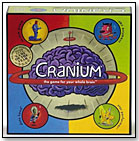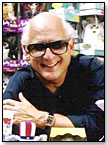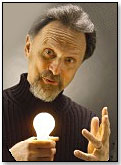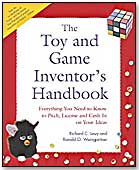
April 3, 2025


 Cranium  Richard C. Levy  Ronald O. Weingartner  The Toy and Game Inventor’s Handbook |
The well publicized story of how Alexander and Tait turned a self-published game, the board game Cranium, into one of the hottest sellers on the shelves of coffee kingpins Starbucks is a case of innovative inventing success thanks to both “know how” and “know who,” according to toy industry veterans Richard C. Levy and Ronald O. Weingartner.
Before its astronomical success, Cranium was the entrepreneurial embryo of two former Microsoft employees. A fortuitous meeting with Starbucks CEO Howard Schultz led to a momentous opportunity to tap into corporate synergy and reach the coveted Starbucks demographic.
During the meeting, Schultz ended up liking the game and bought it for his stores. Fortunately for the pair of inventors, the game coincided with Starbucks’ plans to sell a game in its stores, and the partnership propelled Cranium to the household name-recognition it now enjoys.
| “Amateur toy and game inventors become pros the same way amateur athletes do: through training and competition.” |
Like Alexander and Tait, a toy inventor’s path to success today requires hard work, slavish attention to detail, foolhardy tenacity, a bit of luck and above all, an appreciation of the unique market forces that shape the toy industry. Fortunately for those who harbor dreams of turning their ideas into reality, Levy and Weingartner have created a fun and illuminating guide for inventing success in the toy industry.
Levy and Weingartner’s new book, The Toy and Game Inventor’s Handbook: Everything You Need to Know to Pitch, License and Cash-In on Your Ideas (488 pages, Alpha, $19.95), lays bare the sometimes byzantine and fantastic fraternity of toy inventors, agents and toy company executives. The duo strings together more than 100 interviews in the book, including scores of stories about the hard-won successes of toy inventors, and crucial information for independent inventors, such as how to prepare proposals and prototypes, and how to negotiate and get the best terms.
Levy, who has licensed over 125 original concepts in his 25-plus years in the toy industry, including products like Furby and the best-selling game Men Are From Mars, Women Are From Venus, says that the book speaks to prospective inventors as well as industry veterans looking to gain insight into the creative process.
“Our aim was to write a book that would benefit not only wannabe inventors, but also corporate executives who must interface on a regular basis with the complex species of creative individual known as inventoricus independentava,” Levy said. “We hope that by giving each side a better understanding of the other, there will be even greater synergism between these forces, and that will result in greater successes.”
While his partner Levy has extensive experience as an inventor and author, Weingartner has been the consummate “insider,” working for over 35 years in research and development in the toy industry. He, too, sees a growing need for novice inventors to learn the ropes in the toy industry.
“Throughout my career, I have been involved with highly creative and inventive people both inside and outside companies,” says Weingartner. “I was particularly struck by the external, independent inventors who each year took the challenge of speculating on marketable new ideas for toys and games. I saw many people who wanted to commercialize ideas but who were unaware and naïve about moving ideas to market.”
“There are two kinds of amateur inventors: the paranoid and the more paranoid.” |
The last 15 years have brought dynamic change to the toy industry, and even seasoned toy inventors have been scrambling to find their bearings. While it is still independent inventors who power most of the brightest successes in the lucrative $30-billion a year toy industry (Classics like Pokemon, Cabbage Patch Kids and Etch-a-Sketch are all the brainchildren of independent inventors.), toy inventors today are faced with a diverse set of challenges, according to Levy and Weingartner.
A shrinking number of toy companies, coupled with the continued importance of licensing, retailer consolidation and many toy executives’ “hit mentality,” have changed demands on toy inventors. Weingartner says in most cases independent inventors are up against tremendous odds to bring their idea to fruition.
“Consumer product interests are fickle, and costs that marketers will pay for a ‘WOW’ in a toy are often fractional,” he says. “Fortunately, most toy companies are comfortable and receptive to external inventors, and the business has an insatiable annual capacity for new items. Other sectors tend to be insular and restrictive to external inventors.”
Though the toy business is relatively friendly to inventors, licensing and market factors have made turning an inventor’s dreams into dollars more difficult than ever before, Levy says.
| “Today the industry almost totally relies on classic or entertainment licenses. This is why products do not last long. There can be no evergreens when the forest is cut down each year to make room for the next film or TV show.” |
“The toy industry is one of the last and greatest frontiers for the independent inventor. It’s a fashion industry that cannot afford to get caught with its trends down. It has an insatiable appetite for innovative product,” says Levy, who also wrote 2001’s excellent The Complete Idiot´s Guide® to Cashing in On Your Inventions. “This having been said, it is no cakewalk. Inventors face all kinds of obstacles ranging from the vicissitudes of the marketplace, technical barriers, costing issues, and at some companies, the “Not Invented Here” syndrome.
"When I got into the business 25-plus years ago, it was pure innovation that drove companies, not entertainment licenses,” he says. “Today, the industry almost totally relies on the equity of brands, i.e. marketing products under classic or entertainment licenses. This is why products do not last long. There can be no evergreens when the forest is cut down each year to make room for the next film or TV show.”
Cashing in on your inventions requires new skills and new ways of dealing with the toy industry, but the only way to succeed is with preparation, hard work and a determination bordering on obsession, Levy and Weingartner say.
“Amateur toy and game inventors become pros the same way amateur athletes do: through training and competition,” they write in the Handbook.
To learn more about the Handbook, including purchasing information, please go to www.greatideagear.com/toybook.
Top Tips for New Toy and Game Inventors Don’t
Do
|
Copyright © 2025 TDmonthly®, a division of TOYDIRECTORY.com®,
Inc.